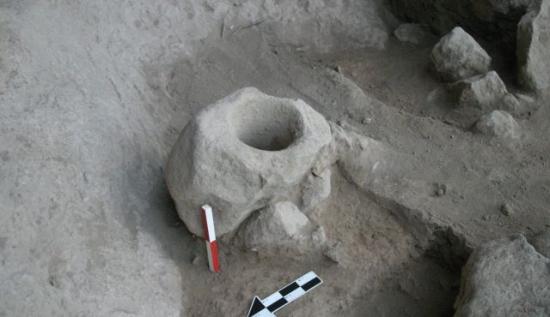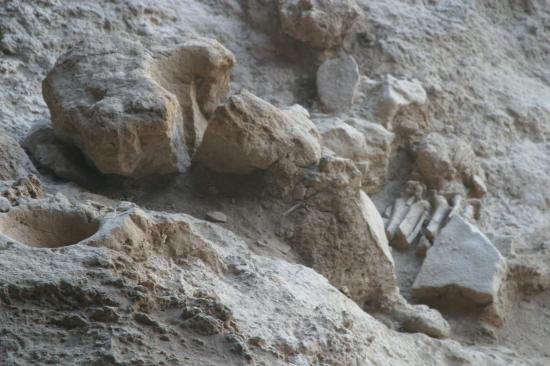Ran Shapira
Source - http://www.haaretz.com/life/archaeology/.premium-1.662574
The sound of the pounding may have been used to summon the late Stone Age community from far and wide for the funeral ritual, Haifa University archaeologists postulate
 A boulder mortar found at the Natufian burial site in Rakefet Cave, Mt. Carmel. Photo by Prof. Danny Nadel
A boulder mortar found at the Natufian burial site in Rakefet Cave, Mt. Carmel. Photo by Prof. Danny Nadel
Enormous mortars carved out of boulders more than 11,000 years ago, found at Natufian burial sites throughout the Levant, have foxed archaeologists for decades. Their sheer size made them inappropriate for casual everyday use in making food, so what were they for? Now archaeologists from Haifa University think they may have cracked the secret.
The mortars were carved mostly out of chalky rock. Some are as much as a meter in height and 100 kilograms in weight. Most were found in burial sites of the Natufian culture, over a wide region in the Middle East.
Over the years, various researchers formulated different theories as to what purpose the mortars served, though based on their location, they seemed to be part of the elaborate burial and commemoration ceremonies of this prehistoric culture, which thrived in the late Stone Age.
Following thorough investigation of a few dozen mortars discovered at various sites, Dr. Danny Rosenberg and Prof. Danny Nadel of the Zinman Institute of Archaeology at the University of Haifa suggest that beyond a possible function in preparing food for the mourners – and possibly offerings to the dead, the sounds produced by pounding these stone vessels, while a Natufian community had gathered to bury or commemorate one of its members, would have been discernable over long distances. It could have served as a signal to bring the ceremony to the attention of neighboring communities.
In other words, pounding the mortar was like a Natufian drum signal, used to bring the community together.
Biggest stone tools of the age
The boulder mortars are the biggest stone tools found in the context of the prehistoric age.Essentially, these are large rocks into which a shaft, rather than a basin shape, was carved out. "The shaft could be, for example, 70 centimeters in depth and only 10 to 20 centimeters in diameter. They were narrow and deep," Nadel told Haaretz. Most of the shafts get narrower as they get deeper, and some of the mortars have holes at the bottom, he and Rosenberg say.
We do not have a clear indication regarding the pestles used with these mortars. Although the Natufians produced neatly-made basalt pestles, these were probably used in other mortars, as they are much shorter than the massive boulder mortar shafts, said Rosenberg. "We assume that at least some of the large mortars were used with large wooden pestles and similarly, the stone pestles were sometimes used with wooden mortars, to process a variety of foodstuffs and maybe other substances, such as ochre," Rosenberg adds.
Calling the living to the dead
What the Natufians did with these monster mortars can only be surmised. But since they were found at burial sites – sometimes within the grave itself, Nadel and Rosenberg think they served a function in the funerary ritual, or in commemorating the dead.
Man has been burying the dead ritualistically for at least tens of thousands of years. There are signs of offerings in graves going back 120,000 years; deliberate burials were also ascribed to the Neanderthals.
However, such ancient graves were isolated. The Natufians, a late Stone Age culture in the Levant that lived 15,000 to 11,000 years ago, are the first people known to have actual graveyards, Nadel explains. "They had more complex ceremonies and were probably the first to use the same location over and over again for burial. In a single small cave we can find up to 100 bodies. Clearly they had a different system of what to do with the dead and some were buried with a giant mortar."
The Natufians were among the first known in the region to abandon the nomadic way of life and settle down, which may help explain why they "invented" the graveyard – and wanted to summon neighbors to their ceremony.
"In a metaphoric and practical way, these large mortars and other basalt and limestone tools served as anchors, as weights tying the Natufians to specific locations in the landscape," said Rosenberg, who heads Haifa University's Laboratory for Ground Stone Tools Research.
 A boulder mortar at the Natufian burial site in Rakefet Cave, Mt. Carmel.
A boulder mortar at the Natufian burial site in Rakefet Cave, Mt. Carmel.
Rudimentary agriculture
The Natufians were also among the first to develop rudimentary agriculture. This transitional period is characterized by the development of stone tools for farming, and to make food. The boulder mortars would have been just one of the array.
No residue of food or anything else have been found inside these boulder mortars. They could have been used to grind grain, to tenderize meat, to ferment juice into alcohol or for some other use. Nor can we say whether the food was meant for the living mourners, or as an offering to accompany the dead on their last journey – or for both the living and the dead.
But if they were involved in food, their sheer dimension indicates that a large amount was being prepared. That and the mortars' location make it unlikely that they were used to prepare food on a daily basis, says Rosenberg – and support the theory of a ceremonial purpose.
Saying it with flowers
Natufian Man is known to have complex funeral rites. Rakefet Cave, on Mount Carmel, contains the earliest known evidence of laying the dead on beds of flowers and leaves some 13,700 years ago. Archaeologists also found evidence of feasting (bones) by large numbers of people by the gravesites, which fits with the theory that the mortars were used in preparing food.
The boulder mortars have been found as far afield as Lebanon and Syria to the north, to the Jordanian desert in the east. A large number was found on Mt. Carmel, in Israel; more have been found in Jericho, and in the Negev desert.
Although theoretically they could be moved, the chances are they weren't, because of their sheer mass. They were used in situ and buried with the dead, or next to the grave, and there they have remained for over 11,500 years.
The boulder mortars, adds Rosenberg, were a part of a complex world of stone tools, which were adapted to the late Stone Age era of the Natufians, and were used for both mundane and more special activities. Many types of stone tools were manufactured at that era, which were used to process food and other materials, and for a wide range of other purposes. The mortars were a unique element of the assembly of stone tools of that era, due to their dimensions and apparent ceremonial function.
The wide area in which they were found indicates that beyond their apparent ceremonial function – preparing food for the burial ceremony and probably sending audio signals about the ceremony – they took part in strengthening the identity of the community, and they provide indication of a wide conventions system which existed in the Middle East 15,000 to 11,500 years ago.